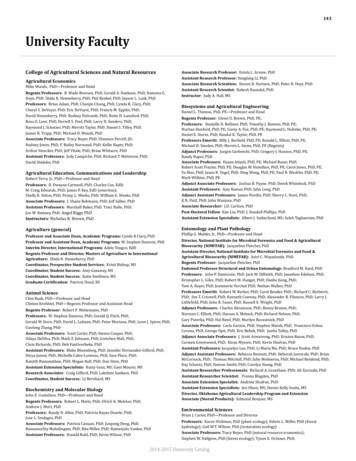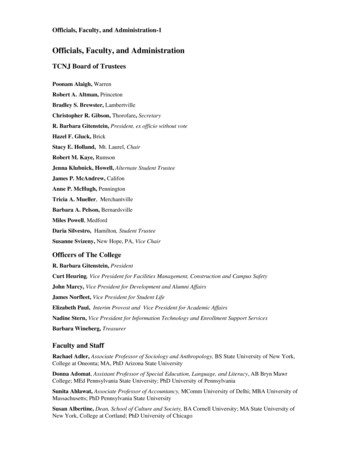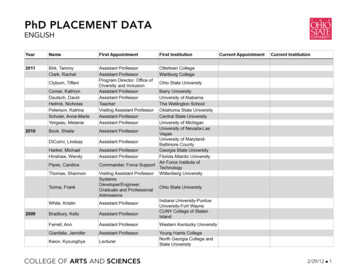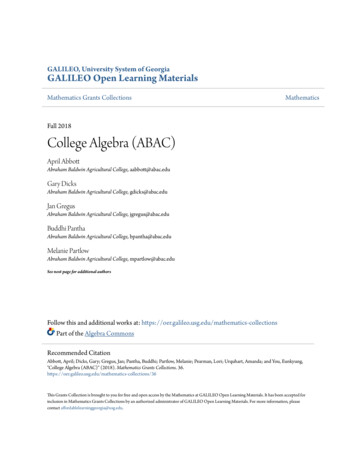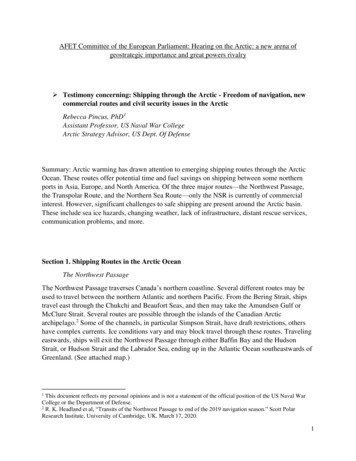
Transcription
AFET Committee of the European Parliament: Hearing on the Arctic: a new arena ofgeostrategic importance and great powers rivalry Testimony concerning: Shipping through the Arctic - Freedom of navigation, newcommercial routes and civil security issues in the ArcticRebecca Pincus, PhD1Assistant Professor, US Naval War CollegeArctic Strategy Advisor, US Dept. Of DefenseSummary: Arctic warming has drawn attention to emerging shipping routes through the ArcticOcean. These routes offer potential time and fuel savings on shipping between some northernports in Asia, Europe, and North America. Of the three major routes—the Northwest Passage,the Transpolar Route, and the Northern Sea Route—only the NSR is currently of commercialinterest. However, significant challenges to safe shipping are present around the Arctic basin.These include sea ice hazards, changing weather, lack of infrastructure, distant rescue services,communication problems, and more.Section 1. Shipping Routes in the Arctic OceanThe Northwest PassageThe Northwest Passage traverses Canada’s northern coastline. Several different routes may beused to travel between the northern Atlantic and northern Pacific. From the Bering Strait, shipstravel east through the Chukchi and Beaufort Seas, and then may take the Amundsen Gulf orMcClure Strait. Several routes are possible through the islands of the Canadian Arcticarchipelago.2 Some of the channels, in particular Simpson Strait, have draft restrictions, othershave complex currents. Ice conditions vary and may block travel through these routes. Travelingeastwards, ships will exit the Northwest Passage through either Baffin Bay and the HudsonStrait, or Hudson Strait and the Labrador Sea, ending up in the Atlantic Ocean southeastwards ofGreenland. (See attached map.)1This document reflects my personal opinions and is not a statement of the official position of the US Naval WarCollege or the Department of Defense.2R. K. Headland et al, “Transits of the Northwest Passage to end of the 2019 navigation season.” Scott PolarResearch Institute, University of Cambridge, UK. March 17, 2020.1
According to Transport Canada, shipping in the Northwest Passage may become more dangerousas a result of climate change. The breakup of thick, multiyear sea ice means that pieces of thisthick, strong ice can flow into shipping lanes, posing “serious navigational challenges”.3In 1985, Canada drew straight baselines around the outer edge of the Canadian Arcticarchipelago, declaring that all of the waters within the archipelago are Canada’s historic internalwaters.4The Government of Canada is focused on protecting the environment of the Northwest Passage,and recognizes the importance of environmental protection to Arctic and northern peoples.Canada’s Arctic and Northern Framework acknowledges that vessel traffic through theNorthwest Passage may be “increasingly feasible at certain times of the year” due to climatechange, but notes that “extremely variable ice conditions continue to make navigation difficultand hazardous.”5 The Framework states that “Canada will continue to manage vessel trafficwithin our national waters to ensure that navigation is conducted in accordance with our rigoroussafety and environmental protection standards.”Transpolar RouteThe Transpolar Route (sometimes referred to as the Transpolar Sea Route, TSR) is, at present, anotional shipping route directly across the Arctic Ocean. As a more direct route, without thedepth restrictions found in parts of the Northwest Passage and Northern Sea Route, theTranspolar Route would offer the greatest potential shipping efficiencies. However, theTranspolar Route is remote from land and does not offer intermediate stopping points fortransshipping. Charting and emergency services are not yet developed, and insurance regimesunclear. It is not yet clear if demand for this route will emerge.6Use of the Transpolar Route would require significant reductions in Arctic sea ice below presentconditions. The Arctic Ocean is expected to be “ice-free” by midcentury, with “ice-free” usuallydefined as 1 million square kilometers. Modeling and observation-based predictions of whenthis will occur reflect lack of consensus, with estimates ranging between 2030 and 2060: recentresearch indicates the 2030s are more likely.7 However, it is important to recall that ice-freeconditions will not persist for longer than a few weeks in September before autumn coolingbegins. Longer periods of ice-free conditions that would permit a shipping season are unlikelyTransport Canada. “Climate change and its impacts on shipping.” zanne Lalonde, “The debate over the legal status of the Northwest Passage.” Brief submitted to Senate ofCanada, Special Committee on the Arctic, October 17, 2018.5Government of Canada, “Canada’s Arctic and Northern Policy Framework.” 2019. 560523330587.6For more, see Mia Bennet, et al, “Climate change and the opening of the Transpolar Sea Route: logistics,governance, and wider geo-economic, societal and environmental impacts. In The Arctic and World Order, KristinaSpohr and Daniel S. Hamilton, eds. e-arctic-and-world-order/.7See, for example: James E. Overland and Muyin Wang, “When will the summer Arctic be nearly sea ice free?”Geophysical Research Letters, Vol 40: 2097-2102, 2013; Ge Peng, et al, “What do global climate models tell usabout future Arctic sea ice coverage changes?” Climate, Vol 8(1): 15, 2020.32
before the end of the century. In addition, the future of Arctic sea ice, particularly at longer timehorizons, will depend on the efforts of the global community to control emissions of CO2 andother greenhouse gases.Northern Sea RouteThe Northern Sea Route (technically, this term refers to a portion of the Northeast Passage,which has been designated as the Northern Sea Route by the Government of Russia; however,Northern Sea Route is in common usage) traverses Russia’s northern coastline. From the BeringStrait, ships travel west through the East Siberian Sea, across the Laptev Sea, the Kara Sea, andthen either north of Novaya Zemlya through Cape Zhelaniya or south through the Kara Gate intothe Barents Sea.8 Ships may stay close to the shore or travel around the New Siberian Islands andSevernaya Zemlya.While shipping speeds vary with operational conditions, the NSR offers significantly shortertrips between some ports: Japan-Rotterdam is 11,000km via Suez, but only about 7,600 via theNSR. In addition, because the Government of Russia is actively developing the NSR as well asnatural resource projects along its route, there are opportunities for intermediate stops andtransshipment.The Government of Russia has stated its intention to develop the NSR into a “globallycompetitive national transport corridor” and President Putin has called for shipping in the NSR toreach 80 million tons by 2024.9 In 2020, shipping volume was nearly 33 million tons, and 31.5million tons in 2019.10 Major development of oil, gas, coal, and other resources along the NSR isanticipated to spur shipping to the desired levels. In order to develop the NSR, the Governmentof Russia offers long-term tax incentives and a free customs zone.11 In addition, icebreakers andother support vessels are planned, as well as regional airports, railways, and seaports.12Arctic warming has already led to reductions in sea ice along portions of the NSR. The AmericanBureau of Shipping (ABS) notes that “enormous variability is inherent” along the NSR, and thatships can expect “strong winds, low air temperatures,” fog, darkness, snow, and storms.13Hazards include whiteout conditions when the horizon can be lost, optical haze, and ice blink.High winds and currents can drive ice quickly, creating dangerous situations. Studies haveSee “Northern Sea Route Shipping Statistics,” PAME Working Group of the Arctic tatistics.9Ekaterina Klimenko, “Russia’s new Arctic policy document signals continuity rather than change,” StockholmInternational Peace Research Institute, April 6, 2020. her-change.10Atle Staalesen, “Overfulfilling the Arctic plan,” The Barents Observer, January 12, SS, “Deputy PM: Russia interested in foreign investment in Northern Sea Route,” July 6, 2020.https://tass.com/economy/1175343.12Atle Staalesen, “Moscow adopts 15-year grand plan for Northern Sea Route,” The Barents Observer, December31, 2019. .13American Bureau of Shipping, “Navigating the Northern Sea Route: Status and Guidance,” ories-and-debriefs/ABS NSR Advisory.pdf.83
explored the relationship between ice conditions, ice strengthening of vessels, and the likelihoodof hazard.14In 1998, the Government of Russia drew straight baselines around its coastline, including theseas and straits “which have historically belonged to the Russia Federation” and described theNSR as “the historical national unified transport line of communication of the RussianFederation.”15 The regulatory regime for the NSR was further developed in 2013, and againrevised in 2017.Section 2. Freedom of navigation in the Arctic OceanIn the Arctic Ocean, the UN Convention on the Law of the Sea (UNCLOS) lays out maritimezones, rights, and responsibilities. This includes the regime of internal waters, territorial seas,exclusive economic zones, and high seas. While the US is not yet a party to UNCLOS, the 2008Ilulissat Declaration, signed by the five coastal Arctic states including the US, stated thatUNCLOS provides “a solid foundation” for Arctic management and that the signatory stateswould “remain committed to” UNCLOS and “see no need to develop a new comprehensiveinternational legal regime”.16UNCLOS does contain a specific provision relevant to the Arctic: Article 234 gives coastal statesthe right to adopt and enforce non-discriminatory laws and regulations against marine pollutionin ice-covered areas, “where particularly severe climatic conditions and the presence of icecovering such areas for most of the year create obstructions or exceptional hazards” and where“pollution could cause major harm to or irreversible disturbance of the ecological balance.”17Freedom of navigation has long been a priority for the United States. Since 1979, the USgovernment has carried out a freedom of navigation program intended to counter excessivemaritime claims around the world. By strongly defending freedom of navigation, the US defends“the rights, freedoms, and uses of the sea and airspace guaranteed to all States underinternational law.”18 The US program is an active program, and through actively counteringexcessive maritime claims, the US prevents those claims from becoming accepted in14For example, see: Jarno Vanhatalo, et al,“Probability of a ship becoming beset in ice along the Northern Sea Route – a Bayesian analysis of real-life data,”Cold Regions Science and Technology, Vol 184, April 2021. Lauri Kuuliala, et al, “Estimating operability of ships in ridged ice fields,” Cold Regions Science and Technology,Vol 135, March 2017. 15Russian Duma,“Federal Act on the international maritime waters, territorial sea and contiguous zone of the Russian Federation,”adopted by the Duma July 16, 1998 and Federation Council July 17, 1998. Articles 1 and 14. Deposited with the UNDivision for Ocean Affairs and the Law of the Sea, Office of Legal DTREATIES/.16The Ilulissat Declaration, May 2008. sat-declaration.pdf.17UN Convention on the Law of the Sea, Part XII, Section 8, Article 234.18US Department of Defense, “Freedom of Navigation Program,” February 28, 2017.4
international law.19 The US program consists of both diplomatic efforts as well as operations byUS military forces, or freedom of navigation operations (FONOPs).20Each year, the US DoD conducts FONOPs. In 2020, 19 countries’ maritime claims werechallenged, some repeatedly.21 In 2019, the claims of 22 countries were challenged22; in 2018,the claims of 26 countries were challenged.23In the Arctic Ocean, the US considers both the claims of Canada and Russia to be excessivemaritime claims.The differences between the US and Canada and Russia are longstanding. The US has disputedthe status of the NSR before the passage of UNCLOS. While Russia maintains that the Vilkitsky,Shokalsky, Sannikov, and Laptev Straits are historic internal waters and therefore subject to theclose regulation accorded internal waters; the US argues that these are international straits andtherefore transit passage rights apply.During the early days of the Cold War, U.S. Coast Guard icebreakers conducted severalscientific missions to demonstrate freedom of navigation through straits claimed by the SovietUnion—although these missions occurred before the days of the U.N. Convention on the Law ofthe Sea (UNCLOS). In 1965 and 1967, however, the Soviets successfully forced the icebreakersto turn back rather than transit through Vilkitsky Strait, which connects the Kara and Laptev seasthrough the Severnaya Zemlya archipelago. Using Soviet Navy ships and planes, as well asstrong diplomatic pressure, Moscow succeeded in getting Washington to back down at the lastmoment. Since then, the United States has not conducted surface FONOPs through the NSR.24In 2015, the US delivered a diplomatic note to Russia objecting to aspects of the NSR regulatoryscheme. In particular, the note flagged the requirement to request permission to enter the NSR,the labeling of the NSR straits (mentioned above) as internal waters, and the lack of anexemption for warships.25 Transit requirements on the NSR have become more stringent inrecent years. While the 2013 regulatory regime reflected Russia’s interest in developing the NSRinternationally, the 2018 regulations are more restrictive: for example, shipping of hydrocarbonsin the NSR is limited to Russian-flagged ships, as is cabotage and other coastal services likesalvage.26 In 2019, new regulations required 45-day advance notification for warship transit ofDepartment of Defense, “Annual Freedom of Navigation Report, Fiscal Year ments/FY20%20DoD%20FON%20Report%20FINAL.pdf.20DoD, “Freedom of Navigation Program.”21Department of Defense, “Annual Freedom of Navigation Report, Fiscal Year 2020.”22Department of Defense, “Annual Freedom of Navigation Report, Fiscal Year 2019.”23Department of Defense, “Annual Freedom of Navigation Report, Fiscal Year 2018.”24Rebecca Pincus, “Rushing Navy Ships into the Arctic for a FONOP is dangerous,” Proceedings, Vol 145, January2019. For more, see J. Ashley Roach, “Freedom of the Seas in the Arctic Region,” in The Arctic and World Order,Kristina Spohr and Daniel S. Hamilton, eds. e-arctic-and-worldorder/.26Arild Moe, “A new Russian policy for the Northern sea route? State interests, key stakeholders and economicopportunities in changing times,” The Polar Journal, Vol 10(2), 2020.195
the NSR, and also required a Russian pilot.27 The advance notification requirement, and lack of acarve-out for warships, appears to break the terms of a 1989 agreement between the US and theSoviet Union regarding innocent passage for warships.28Similarly, the US disputes Canada’s characterization of the straits in the Northwest Passage asinternal waters. The US maintains that these are international straits. In 1985, the transit of theUS icebreaker Polar Star through the Northwest Passage triggered a diplomatic storm betweenthe US and Canada.29 In 1988, the two states signed an Agreement on Arctic Cooperation thatestablished a neutral solution: “The Government of the United States pledges that all navigationby US icebreakers within waters claimed by Canada to be internal will be undertaken with theconsent of the Government of Canada.”30This agreement has enabled relations between the US and Canada over the Northwest Passage toremain cooperative. In 2018, the US Coast Guard cutter Maple transited the Northwest Passageescorted by the Canadian icebreaker Sir Wilfrid Laurier and others.31 In the summer of 2021, theUS Coast Guard icebreaker Healy will conduct a transit of the Northwest Passage in cooperationwith Canada; a Coast Guard representative underlined the cooperative nature of the jointoperation: “definitely not a FONOP.”32Section 3. Civil security issues in the ArcticStrong regional differences exist around the Arctic Ocean. What is common is extreme weather,uncertainty associated with climate change, and problems with situational awareness,communications, specialized equipment, and availability of services.33 There is consensus amongthe Arctic states on the importance of human safety and environmental protection, andrecognition that cooperation on search and rescue (SAR), maritime environmental response, andsimilar civil security issues is of great importance.In the North American Arctic, including Canada and Alaska (US), first responders are hamperedby lack of infrastructure, adverse weather, and communication challenges. While theThe Maritime Executive, “Russia Tightens Control Over Northern Sea Route,” March 8, drey Todorov, “Where does the Northern Sea Route lead to?” Russian International Affairs ute-lead-to/.29Janet Cawley, “US, Canada in Cold War Over Who Rules the Arctic Waters,” Chicago Tribune, August 18, 85-08-18-8502230914-story.html.30Government of Canada, “Agreement Between the Government of Canada and the Government of the UnitedStates of America on Arctic Cooperation.” 1989.31Robert Woolsey, “USCG Maple’s ‘tense’ voyage through icy NW Passage,” KCAW, February 1, ense-voyage-icy-nw-passage/.32Melody Schreiber,“US Coast Guard announces plans to transit the Northwest Passage this summer,” Arctic Today, March 13, passage-thissummer/.33Finnish Red Cross, “Red Cross Arctic Disaster Management Study,” Finnish Border Guard, 2018.276
Governments of Canada and the United States are building capacity for human andenvironmental security, the sheer size and remoteness of the region will remain a challenge. Inparticular, growing marine tourism and larger cruise ships pose a risk to human andenvironmental security in the region.34Russia faces similar challenges in developing adequate civil security capacity across the NSR.While the western portion of the NSR has much more developed response capacity, particularlyin the Kola area, the eastern portion of the NSR has gaps. The Government of Russia has statedits intention of building out response capacity along the NSR, including both a large new fleet ofrescue vessels and onshore rescue coordination centers in Sabetta, Dikson, Tiksi, and Pevek.This is an important step, given the significant increases in industrial and resource-based activityin the region, which carry risk to human and environmental security. At the same time, Russia isbuilding out its military capacity along the NSR, not only around the “bastion” of the Kolapeninsula but eastwards as well. New military infrastructure and capabilities in the NSR includeearly warning sensors, air defense systems, and airfields, as well as new vessels and otherplatforms.35Multiple actors are involved in the provision of human and environmental security in Russia’sArctic, which can result in slow progress and uncertain responsibility.36 Russia’s Coast Guard isa department of the FSB’s Border Guard Service. Its missions include: protecting living marineresources and enforcing fishing in transboundary and highly migratory species, coordinatingenforcement and border control of maritime borders, inland waters, territorial seas, EEZ, andcontinental shelf areas, participating in combatting maritime crime, and participating in maritimesearch and rescue.37 At the federal level where this analysis is focused, three ministries areinvolved in the missions of SAR and spill response: the Ministry of Defense (for emergenciesrelating to the armed forces), the Ministry of Emergencies (EMERCOM), and the Ministry ofTransport.38 The Ministry of Transport oversees Maritime Rescue Coordination Centers (MRCC)and Subcenters (MRCS), and EMERCOM oversees regional crisis management centers. Inaddition, the Northern Fleet maintains a Search and Rescue Administration, and the NorthernExpeditionary Unit of rescue and salvage operations. Maritime SAR is the responsibility of theMaritime Rescue Service (Morspassluzhba) of the Federal Marine and River Transport Agency(Rosmorrechflot), within the Ministry of Transport. The Northern Expeditionary Unit is a federalSee, for example, “Changes in the Arctic: Background and Issues for Congress,” Congressional Research Service,R41153, February 1, 2021.35Matheiu Boulegue, “Russia’s Military Posture in the Arctic,” Chatham House, June 28, -bastion.36Atle Staalesen, “Government wrangles over Arctic search and rescue,” The Barents Observer, December 9, ctic Coast Guard Forum, Russia page. ry/russia.38Ingvill Moe Elgsaas. The Arctic in Russia’s Emergency Preparedness System. Arctic Review on Law and Politics,December 2018. DOI: 10.23865/arctic.v9.1131.347
state institution with missions of ensuring safety and performing SAR for the fishing fleet in thenorth.39In the Scandinavian Arctic, infrastructure is well-developed and sea ice presents less of a hazard.It is therefore the region with the greatest capacity for human and environmental security,although difficulties persist. Tourism is also growing in this region, posing a challenge for firstresponders.The Arctic Council has a Working Group on Emergency Prevention, Preparedness and Response(EPPR), which works to address the risk of emergencies, accidents, and search and rescueincidents to both human and environmental security.40 EPPR maintains the operationalguidelines for two of the legally binding agreements in the Arctic, the Search and RescueAgreement and the Marine Oil Pollution Preparedness and Response Agreement.41In 2015, the Arctic Coast Guard Forum (ACGF) was established. It is an operationally-focused,consensus-based organization that builds coordination among the coast guards of the eight Arcticnations. The ACGF conducts regular live and tabletop exercises to develop coordination. InApril 2021, the ACGF and the EPPR will hold a joint online emergency response exercise,hosted by Iceland, to improve Arctic nations’ capability to response to maritime incidentsrequiring joint search and rescue and marine environmental response operations.42 The exercise,called Arctic Guardian 2021, will feature a scenario in which an oil tanker and an expeditionarycruise vessel collide off the north coast of Iceland.Svetlana Kuznetsova, Alexander Suslov, Ivan Saveliev, Dmitry Kochegarov, Maxim Zadorin, “Russia’sPreparedness Capacities, Challenges and Need for Cooperation,” in Maritime Emergency Preparedness Resourcesin the Arctic-Capacity Challenges and the Benefits of Cross-Border Cooperation between Norway, Russia, Icelandand Greenland. MARPART Project Report 4, eds. Natalia Andreassen, Odd Jarl Borch, Johannes Schmied. 2018.40Arctic Council, “Emergency Prevention, Preparedness and Response.” eppr/.41Ibid.42Arctic Council, “EPPR and Arctic Coast Guard Forum Hold Joint Exercise to Improve Arctic MaritimeEmergency Response,” ency-response/.398
Charts of Arctic Shipping Routes1. Three major shipping routes9
2. Potential savings compared to current shipping lanes10
3. The Northwest Passage11
4. The Northern Sea Route12
Assistant Professor, US Naval War College Arctic Strategy Advisor, US Dept. Of Defense Summary: Arctic warming has drawn attention to emerging shipping routes through the Arctic Ocean. These routes offer potential time and fuel savings on shipping between some northern ports in Asia, Europe, and North America.




